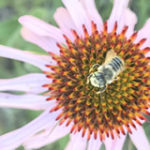V03-1, Fall 1989 – In “Montana Lichens… the Big Picture,” Bruce McCune offers a primer on lichens found in the state and recommends ways to begin studying them more closely; “Genetically Altered Fungus Used on Missoula Weeds” is an MSU news service report on the use of Sclerotinia sclerotiorum fungus for broadleaf weed control; Bill Tall Bull discusses the Cheyenne view of the close relationship between plants, animals, and humans in the cycle of life; Kathy Ahlenslager reviews A Field guide to Wildflowers of the Southern Interior of British Columbia and Adjacent Parts of Washington, Idaho, and Montana by Joan Burbridge, 1989; “An Update on Biological Control of Diffuse and Spotted Knapweed” is an adaptation of an article by Sara S. Rosenthal; a whole series of great field trip reports covering the state from Yellowstone to Glacier are included with detailed species lists; and a book review of Great Escapes: Montana’s State Parks written by Rick Newby.
V03-2, Winter 1990 – Steve Shelly profiles one of Montana’s rare and endangered plants, “Lemhi Beardtongue”; Peter Lesica illustrates a very strange plant, Manypeeplia upsidownia; a Bert Lindler article reprinted from the Great Falls Tribune discusses the efforts of Wayne Phillips and several volunteers to document some rare orchids along the Rocky Mountain Front in “Rare Plants Found in New Areas along Front… Orchid Hunt Succeeds”; “McWenneger Slough” is a field trip report by Anne Garde documenting a number of aquatic species seen there; and Anne Banks reviewed Rare Plants of Colorado published by the Colorado Native Plant Society.
V03-3, Spring 1990 – Judy Hoy describes many plants found on her Ravalli County land that are unique or uncommon in the area, thus her “Bitterroot Valley Refugium”; Carol Morris describes “Propagating Wild Violets for your Garden”; “Lee Metcalf National Wildlife Refuge Plant Slides” by Sheila Morrison describes a project that offered a set of 140 instructional slides with commentary on the plants of the refuge; in “Wildcrafting in Montana,” Robyn Klein describes the myriad medicinal uses for plants and the importance of taking care of the species when removing plants from natural environments; Steve Wirt describes, “Limestone Columbine,” Aquilegia jonesii.
V03-4, Summer 1990 – “Assumptions, Facts – and Lack of Facts – About Seeds”; John Pierce has advice on “Getting Started with Douglasia”; and among several field trip reports is one on “Life on the Ledges of Blodgett Canyon” with a list of species quite uncommon.




